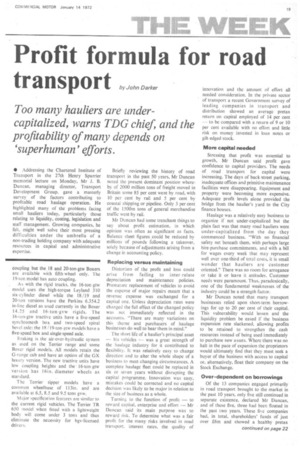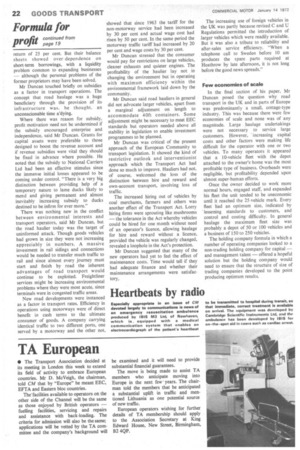Profit formula for road
Page 21

Page 24

If you've noticed an error in this article please click here to report it so we can fix it.
transport by Joh Da ke
Too many hauliers are under capitalized, warns TDG chief, and the profitability of many depends on 'superhuman' efforts.
• Addressing the Chartered Institute of Transport in the 27th Henry Spurner memorial lecture on Monday, Mr J. B. Duncan, managing director, Transport Development Group, gave a masterly survey of the factors contributing to profitable road haulage operation. He highlighted many of the problems facing small hauliers today, particularly those relating to liquidity, costing, legislation and staff management. Growing companies. he felt, might well solve their most pressing difficulties under the umbrella of a non-trading holding company with adequate resources in capital and administrative expertise. Briefly reviewing the history of road transport in the past 50 years, Mr Duncan noted the present dominant position whereby of 2000 million tons of freight moved in Britain some 85 per cent went by road, with 10 per cent by rail and 5 per cent by coastal shipping or pipeline. Only 3 per cent of the 1500m tons of general merchandise traffic went by rail.
Mr Duncan had some trenchant things to say about profit estimation, in which opinion was often as significant as facts. Balance sheet figures ,could be reduced by millions of pounds following a takeover, solely because of adjustments arising from a change in accounting policy.
Replacing versus maintaining Distortion of the profit and loss could arise from failing to inter-relate depreciation and maintenance policies. Premature replacement of vehicles to avoid the expense of major repairs meant that a revenue expense was exchanged for a capital one. Unless depreciation rates were changed the full effect of the changed policy was not immediately reflected in the accounts. "There are many variations on this theme and purchasers of haulage businesses do well to bear them in mind."
The short life of a haulier's principal asset — his vehicles — was a great strength of the haulage industry for it contributed to flexibility. It was relatively easy to change direction and to alter the whole shape of a business to meet changing circumstances. A complete haulage fleet could be replaced in six or seven years without disrupting the capital programme, Innovation was easy, mistakes could be corrected and no capital decision was likely to be major in relation to the size of business as a whole.
Turning to the function of profit — to reward capital, enterprise and effort — Mr Duncan said its main purpose was to reward risk. To determine what was a fair profit for the many risks involved in road transport, interest rates, the quality of innovation and the amount of effort all needed consideration. In the private sector of transport a recent Government survey of leading companies in transport and distribution showed an average pretax return on capital employed of 14 per cent to be compared with a return of 9 or 10 per cent available with no effort and little risk on money invested in loan notes or gilt-edged stock.
More capital needed Stressing that profit was essential to growth, Mr Duncan said profit gave confidence to capital providers. The needs of road transport for capital were increasing. The days of back-street parking, inadequate offices and primitive maintenance facilities were disappearing. Equipment and property were becoming more expensive. Adequate profit levels alone provided the bridge from the haulier's yard to the City finance houses.
Haulage was a relatively easy business to organize if not under-capitalized but the plain fact was that many road hauliers were under-capitalized from the day they commenced business. "With no financial safety net beneath them, with perhaps large hire-purchase commitments, and with a bill for wages every week that may represent well over one-third of total costs, it is small wonder that hauliers are customer oriented." There was no room for arrogance or take it or leave it attitudes. Customer needs were paramount. Thus, paradoxically, one of the fundamental weaknesses of the industry could be a strength factor.
Mr Duncan noted that many transport businesses relied upon short-term borrowings for up to 20 per cent of their capital. This vulnerability would lessen and the liquidity problem be eased if the business expansion rate slackened, allowing profits to be retained to strengthen the cash resources instead of being used immediately to purchase new assets. Where there was no halt in the pace of expansion the proprietors would ultimately find that they must seek a buyer of the business with access to capital or, alternatively, float their company on the Stock Exchange.
Over-dependent on borrowings
Of the 13 companies engaged primarily in road transport brought to the market in the past 10 years. only five still continued in separate existence, declared Mr Duncan, and of these five, three had been floated in the past two years. These five companies had, in total, shareholders' funds of just over £6m and showed a healthy pretax return of 25 per cent. But their balance sheets showed over-dependence on short-term borrowings, with a liquidity problem common to expanding businesses — although the personal problems of the former proprietors may have been solved.
Mr Duncan touched briefly on subsidies as a factor in transport operations. The concept that road haulage was a huge beneficiary through the provision of its infrastructure was, he thought, an unconscionable time a'dying.
Where there was reason for subsidy, profit motivation need not be undermined if the subsidy encouraged enterprise and independence, said Mr Duncan. Grants for capital assets were preferable to those designed to boost the revenue account and if revenue subsidies were vital they should be fixed in advance where possible. He noted that the subsidy to National Carriers Ltd had been an effective stimulus since the immense initial losses appeared to be coming under control. "There is a very big distinction between providing help of a temporary nature to lame ducks likely to mend and giving permanent and almost inevitably increasing subsidy to ducks destined to be infirm for ever more."
There was nothing new in the conflict between environmental interests and transport operators, said Mr Duncan, but the road haulier today was the target of uninformed attack. Though goods vehicles had grown in size they were not increasing appreciably in numbers. A massive investment in rail sidings and connections would be needed to transfer much traffic to rail and since almost every journey must start and finish by road the inherent advantages of road transport would continue to be exploited. Freightliner services might be increasing environmental problems where they were most acute, since terminals were in congested traffic areas.
New road developments were instanced as a factor in transport rates. Efficiency in operations using motorways were of direct benefit in cash terms to the ultimate consumer of goods. A company carrying identical traffic to two different ports, one served by a motorway and the other not, showed that since 1963 the tariff for the non-motorway service had been increased by 30 per cent and actual wage cost had risen by 50 per cent. In the same period the motorway traffic tariff had increased by 20 per cent and wage costs by 30 per cent.
Mr Duncan stressed that the consumer would pay for restrictions on large vehicles, cleaner exhausts and quieter engines. The profitability of the haulier lay not in changing the environment but in operating with maximum efficiency within the environmental framework laid down by the community.
Mr Duncan said road hauliers in general did not advocate larger vehicles, apart from a marginal adjustment on length to accommodate 40ft containers. Some adjustment might be necessary to meet EEC standards but operators needed above all stability in legislation to enable investment programmes to be planned.
Mr Duncan was critical of the present approach of the European Community to transport legislation. It showed the kind of restrictive outlook and interventionist approach which the Transport Act had done so much to improve. Hauliers had not, of course, welcomed the loss of the distinction between hire and reward and own-account transport, involving loss of traffic.
The increased hiring out of vehicles by coal merchants, farmers and others was another effect of the Transport Act. Lorry hiring firms were sprouting like mushrooms — the tolerance in the Act whereby vehicles could be hired for one month without need of an operator's licence, allowing haulage for hire and reward without a licence, provided the vehicle was regularly changed, revealed a loophole in the Act's protection.
Mr Duncan suggested that many of the new operators had yet to feel the effect of maintenance costs. Time would tell if they had adequate finance and whether their maintenance arrangements were satisfactory.
















































































































